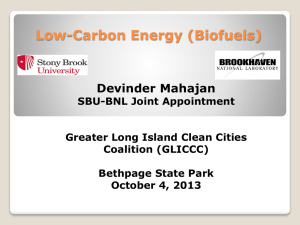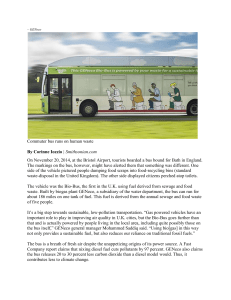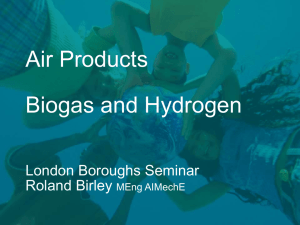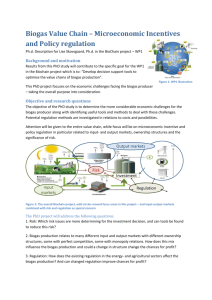PERFORMANCE AND EMISSION CHARACTERISTICS OF 4 STROKE PETROL ENGINE FUELED WITH
advertisement
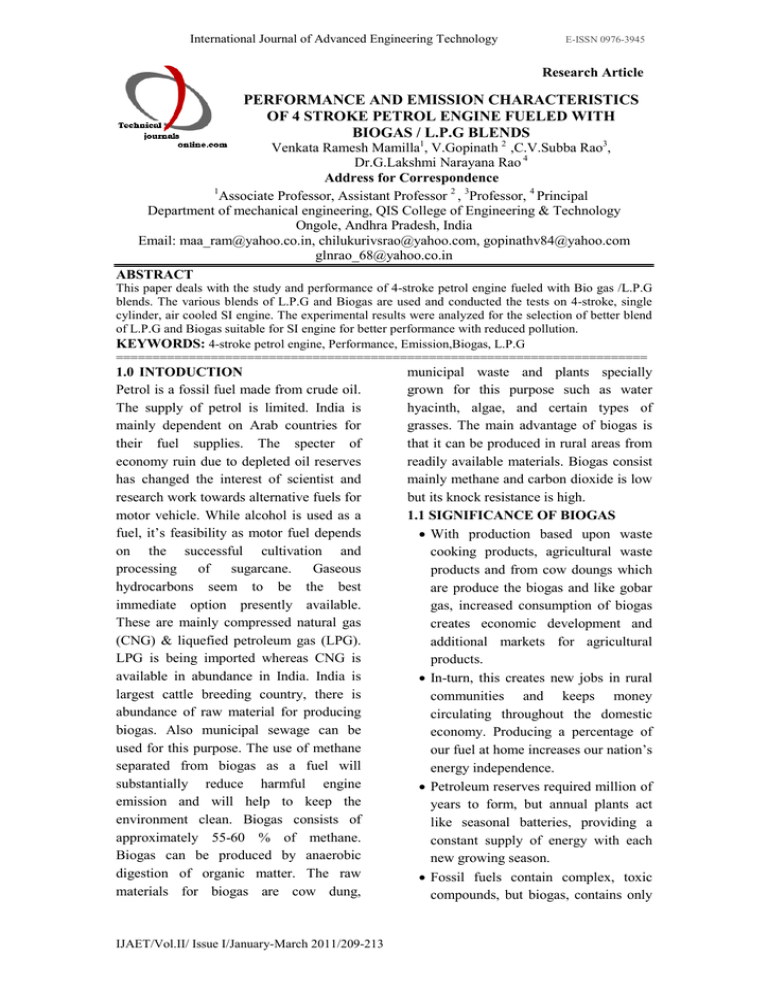
International Journal of Advanced Engineering Technology E-ISSN 0976-3945 Research Article PERFORMANCE AND EMISSION CHARACTERISTICS OF 4 STROKE PETROL ENGINE FUELED WITH BIOGAS / L.P.G BLENDS Venkata Ramesh Mamilla1, V.Gopinath 2 ,C.V.Subba Rao3, Dr.G.Lakshmi Narayana Rao 4 Address for Correspondence 1 Associate Professor, Assistant Professor 2 , 3Professor, 4 Principal Department of mechanical engineering, QIS College of Engineering & Technology Ongole, Andhra Pradesh, India Email: maa_ram@yahoo.co.in, chilukurivsrao@yahoo.com, gopinathv84@yahoo.com glnrao_68@yahoo.co.in ABSTRACT This paper deals with the study and performance of 4-stroke petrol engine fueled with Bio gas /L.P.G blends. The various blends of L.P.G and Biogas are used and conducted the tests on 4-stroke, single cylinder, air cooled SI engine. The experimental results were analyzed for the selection of better blend of L.P.G and Biogas suitable for SI engine for better performance with reduced pollution. KEYWORDS: 4-stroke petrol engine, Performance, Emission,Biogas, L.P.G ========================================================================= 1.0 INTODUCTION Petrol is a fossil fuel made from crude oil. The supply of petrol is limited. India is mainly dependent on Arab countries for their fuel supplies. The specter of economy ruin due to depleted oil reserves has changed the interest of scientist and research work towards alternative fuels for motor vehicle. While alcohol is used as a fuel, it’s feasibility as motor fuel depends on the successful cultivation and processing of sugarcane. Gaseous hydrocarbons seem to be the best immediate option presently available. These are mainly compressed natural gas (CNG) & liquefied petroleum gas (LPG). LPG is being imported whereas CNG is available in abundance in India. India is largest cattle breeding country, there is abundance of raw material for producing biogas. Also municipal sewage can be used for this purpose. The use of methane separated from biogas as a fuel will substantially reduce harmful engine emission and will help to keep the environment clean. Biogas consists of approximately 55-60 % of methane. Biogas can be produced by anaerobic digestion of organic matter. The raw materials for biogas are cow dung, IJAET/Vol.II/ Issue I/January-March 2011/209-213 municipal waste and plants specially grown for this purpose such as water hyacinth, algae, and certain types of grasses. The main advantage of biogas is that it can be produced in rural areas from readily available materials. Biogas consist mainly methane and carbon dioxide is low but its knock resistance is high. 1.1 SIGNIFICANCE OF BIOGAS • With production based upon waste cooking products, agricultural waste products and from cow doungs which are produce the biogas and like gobar gas, increased consumption of biogas creates economic development and additional markets for agricultural products. • In-turn, this creates new jobs in rural communities and keeps money circulating throughout the domestic economy. Producing a percentage of our fuel at home increases our nation’s energy independence. • Petroleum reserves required million of years to form, but annual plants act like seasonal batteries, providing a constant supply of energy with each new growing season. • Fossil fuels contain complex, toxic compounds, but biogas, contains only International Journal of Advanced Engineering Technology simple organic compounds that are non-toxic and biodegradable, making it safe to store and handle. • Using biogas in place of petrol decreases hydro carbon emissions (greenhouse gases) by nearly 65%. • The inherent lubricity of Biogas increases the performance of an internal combustion engine. Biogas is a "premium" natural gas fuel that cleans your fuel system, improves engine lubricity and reduces particulate emissions, all of which help to extend the life of your engine equipment. 1.2 PROPERTIES OF BIOGAS E-ISSN 0976-3945 2.1 ENGINE SPECIFICATIONS BHP :7 SPEED : 8000 RPM BORE : 50mm STROKE : 60mm ORIFICE DIA : 20mm COMPRESSION RATIO : 17.5:1 2.2 EXPERIMENTAL PROCEDURE FOR GAS FUELS 1. Connect the gas regulator to the gas cylinder. 2. Place the gas flow meter between the regulator and gas kit. 3. And check the any leakage from the pipes and tight the pipe clamps. 4. Open regulator valve, gas flows to the engine. Biogas Physical values Characteristics 5. The fan is supplied air to the engine Specific gravity 0.87 to 0.9 for cooling. Density of the gas 1.21 6. The electrical power is supplied to (kg/m ³ ) Octane number 46 to 70 the panel instrumentation. Calorific value (kJ/kg) 24410 7. Fill up water in water rheostat to a • 1m3 Biogas of generates 1.5KWh required height and add salt • 1m3 of Biogas is equals to the 0.54 liters (approximately 500 gm in filled of diesel water tank). • 1m3 of Biogas is equals to the 0.52 liters 8. Confirm that the engine in neutral of petrol gear, put off main switch of rheostat • 1m3 of Biogas is equals to the 1lb of and ignition switch of engine is LPG ‘ON’. • Biogas contains 65% CH4 , 35% CO2 9. Press the choke knob and give a 2.0 EXPERIMENTAL SETUP sharp kick, engine will start. As the engine starts, release the knob and allowed it to run at a rated RPM i.e. 7200 RPM, pull the clutch lever and put the engine in 4th gear. 10. 10. Slowly increase the accelerator and set the generator speed to 900 rpm. 11. 11. The engine is loaded by rotate the knob (on panel) in clock wise direction so that the engine gets loaded. (take sufficient load) 12. Note down time for 3000 c.c fuel consumption from the gas flow meter, ammeter and voltmeter reading. IJAET/Vol.II/ Issue I/January-March 2011/209-213 International Journal of Advanced Engineering Technology 13. Increase the load, adjust the engine speed and note down the readings. 14. Connect the emission probe to the exhaust analyzer engine exhaust for emission values 15. Readings are noted and tabulated at 900 RPM. • Speed of the engine in RPM (N). • Current from ammeter (I). • Voltage from volt meter (S). • Time taken for 3000cc fuel consumption in seconds (t) from gas flow meter • Emission values of CO, CO2, NOx and HC 16. Repeat the procedure for different current values. 3.0 PERFOMANCE ANALYSIS 3.1 SPECIFIC FUEL CONSUMPTION Figure -1 From the above figure-1,it is observed that SFC is maximum at low brake power and is decreasing with increase of brake power for all blends of fuel. For a blend of 50% the SFC is same with compare to the Petrol at low brake power values and is very close to petrol at high values of brake power. Hence at thoe blend of 40 % of biogas the performance of the engine is good. 3.2 BRAKE THERMAL EFFICIENCY IJAET/Vol.II/ Issue I/January-March 2011/209-213 E-ISSN 0976-3945 Figure -2 From the above figure – 2 , it is observed that the nature of brake thermal efficiency at all points of brake power for all fuels. It is also observed that the brake thermal efficiency is higher for the gaseous fuel with compared to the petrol. It is due to the high homogente for gaseous fuel with compare to the petrol. 3.3 MECHANICAL EFFICIENCY Figure - 3 From the above figure - 3, it is observed that mechanical efficiency is minimum at low bp and it increasing with increaseof brake power for all fuels. For a blend of 50%, the mechanical efficiency is high with compare to the other fuels at all brake power values. The blend of 50 % of biogas the performance of the engine is good. International Journal of Advanced Engineering Technology 4.0 EMISSION CHARACTERSTICS 4.1 CARBON MONOXIDE (CO) E-ISSN 0976-3945 the emission value of NOx are minimum for the biogas blend with compared to the petrol. Because it is a low calorific value fuel and it is a homogenous mixture. That’s why, there is no formation of NOx. 4.3 HYDRO CARBONS (HC) From figure - 6, it is observed that HC decreases with increasing load for all fuels. The comparison of HC emissions for petrol, L.P.G and the blend with biogas are shown in Fig. It can be seen that the HC emissions decrease with increase in percentage of biogas in the L.P.G-Biogas fuel blend Figure - 4 The CO values with break power for different fuels are shown in above figure 4 , it is observed that the CO decreases with increasing load for all the blends. For different blends of biogas, CO is reducing. It can be observed that blending 50% of biogas with L.P.G results high reduction in CO emissions when compared to that of petrol, L.P.G, 40% blending. 4.2 NITROGEN OXIDES (NOx) Figure - 5 The comparison of NOx emissions compared with brake power for petrol, L.P.G and the blend with biogas are shown in Fig 5, it is observed that NOx increases with increasing load for all fuels. If the percentage of Biogas increases, NOx will increased because of biogas contains CO2. From the figure it is observed that IJAET/Vol.II/ Issue I/January-March 2011/209-213 Figure - 6 The HC decrease for Biogas may be associated with there is proper combustion is takes place. Above fig. shows HC are less for the 50% Biogas with compare to the L.P.G, 40% Blend and more when compare to the petrol why because petrol is a gaseous fuel. 5.0 CONCLUSION From the results, it is clear that at 50% blending of biogas the engine performance is found to be very appreciable. At this 50% blending trial particularly at full load the specific fuel consumption and brake thermal efficiency are high when compare to the petrol, LPG and the mechanical efficiency is high for the 50% blending with compared to the Petrol, L.P.G, and 40% Blending. And, also the emission values of CO, HC and NOx are minimum for the biogas when compared to the International Journal of Advanced Engineering Technology petrol, L.P.G. when the blending percentage increases the emission values are decreased. The petroleum fuel with its combustion products, pollute the air to great extent. In this case the intensity of pollution problem will be less because of blending this eco-friendly fuel biogas. Thus biogas may be the promising fuel for the future. 6.0 REFERENCES 1. 2. 3. 4. 5. 6. 7. 8. Thring, R. H., “Alternative Fuels for Spark-Ignition Engines,” SAE Paper no. 831685, 4715–25, 1983. Richard Stone, “Introduction to Internal Combustion Engines”, 3rd Edition, Macmillan Press, 1999. Dagaut, P. and Ali. H., “Kinetics of Oxidation of a LPG Blend Mixture in a JSR: Experimental and Modeling Study,” Fuel Journal.82, 475–80, 2003. Prausnitz, P. and Reid, R.C., “The Properties of Gases and Liquids,” McGraw-Hill, 1987. Saw ant H.N., Emission and performance characteristics of a petrol Engine using emulsions of diesel fuel with water, methanol and ethanol. Proceedings of the XI national conference on IC engines and combustion,1989. Alternative Fuels: Emissions, Economics, and Performance, Timothy T. Maxwell and Jesse C. Jones, 1995. Auto LPG: Global Review and Criteria for Success, R. Groeneveld. Emission Comparison of LPG / Gasoline / Diesel in passenger Cars, TNO Road Vehicles Research Institute, November 1993 IJAET/Vol.II/ Issue I/January-March 2011/209-213 E-ISSN 0976-3945

